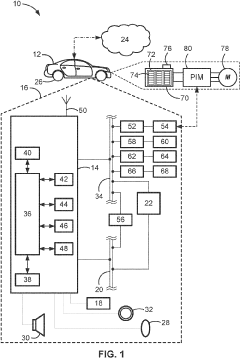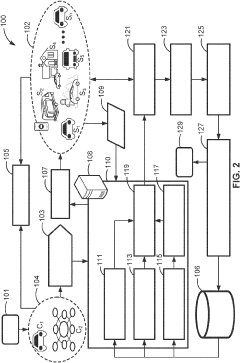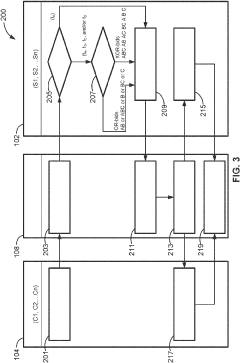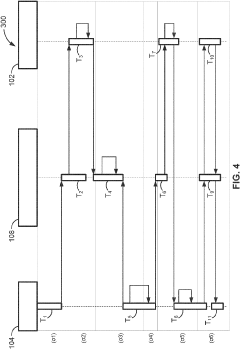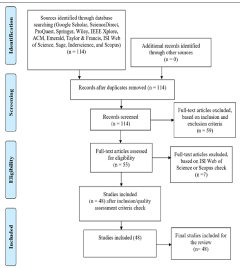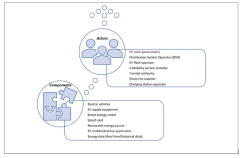How V8 Engines Are Vital for Smart City Infrastructure?
JUL 4, 20259 MIN READ
Generate Your Research Report Instantly with AI Agent
Patsnap Eureka helps you evaluate technical feasibility & market potential.
V8 Engine Evolution and Smart City Goals
The evolution of V8 engines and their integration into smart city infrastructure represents a significant technological leap in urban development. Originating as powerful automotive powerplants, V8 engines have undergone substantial transformations to become vital components in smart city systems. This evolution aligns with the overarching goals of creating more efficient, sustainable, and technologically advanced urban environments.
V8 engines, known for their robust performance and reliability, have been adapted to serve as generators and power sources in smart city applications. Their journey from vehicle propulsion to urban infrastructure highlights the innovative repurposing of established technologies to meet new challenges. The transition reflects a broader trend of leveraging existing industrial strengths to support smart city initiatives.
In the context of smart cities, the goals associated with V8 engine integration are multifaceted. Primarily, these engines contribute to the development of resilient and distributed power generation systems. By providing localized energy sources, V8 engines help create a more robust and flexible urban power grid, capable of withstanding disruptions and meeting fluctuating demand patterns.
Another key objective is the enhancement of emergency response capabilities. V8 engines, when integrated into mobile command centers or emergency vehicles, ensure continuous power supply during crises, supporting critical communication and coordination efforts. This application directly contributes to the smart city goal of improved public safety and disaster resilience.
The adaptation of V8 engines also aligns with smart cities' sustainability objectives. Modern iterations of these engines are being optimized for alternative fuels and increased efficiency, reducing environmental impact while maintaining high performance. This evolution supports the broader smart city goal of transitioning towards cleaner, more sustainable energy sources.
Furthermore, the integration of V8 engines into smart city infrastructure aims to optimize resource utilization. By employing these engines in peak-shaving applications or as part of smart grid systems, cities can better manage energy consumption, reduce strain on the main power grid, and potentially lower overall energy costs.
The technological trajectory of V8 engines in smart cities also encompasses their integration with IoT and AI systems. This convergence enables predictive maintenance, real-time performance monitoring, and adaptive power generation, aligning with the smart city vision of data-driven, intelligent urban management.
V8 engines, known for their robust performance and reliability, have been adapted to serve as generators and power sources in smart city applications. Their journey from vehicle propulsion to urban infrastructure highlights the innovative repurposing of established technologies to meet new challenges. The transition reflects a broader trend of leveraging existing industrial strengths to support smart city initiatives.
In the context of smart cities, the goals associated with V8 engine integration are multifaceted. Primarily, these engines contribute to the development of resilient and distributed power generation systems. By providing localized energy sources, V8 engines help create a more robust and flexible urban power grid, capable of withstanding disruptions and meeting fluctuating demand patterns.
Another key objective is the enhancement of emergency response capabilities. V8 engines, when integrated into mobile command centers or emergency vehicles, ensure continuous power supply during crises, supporting critical communication and coordination efforts. This application directly contributes to the smart city goal of improved public safety and disaster resilience.
The adaptation of V8 engines also aligns with smart cities' sustainability objectives. Modern iterations of these engines are being optimized for alternative fuels and increased efficiency, reducing environmental impact while maintaining high performance. This evolution supports the broader smart city goal of transitioning towards cleaner, more sustainable energy sources.
Furthermore, the integration of V8 engines into smart city infrastructure aims to optimize resource utilization. By employing these engines in peak-shaving applications or as part of smart grid systems, cities can better manage energy consumption, reduce strain on the main power grid, and potentially lower overall energy costs.
The technological trajectory of V8 engines in smart cities also encompasses their integration with IoT and AI systems. This convergence enables predictive maintenance, real-time performance monitoring, and adaptive power generation, aligning with the smart city vision of data-driven, intelligent urban management.
Smart City Infrastructure Demand Analysis
The demand for smart city infrastructure is rapidly growing as urban populations increase and cities face challenges in managing resources, improving efficiency, and enhancing the quality of life for residents. V8 engines play a crucial role in meeting these demands by providing powerful and efficient solutions for various smart city applications.
One of the primary drivers for smart city infrastructure is the need for sustainable transportation systems. V8 engines, known for their high performance and reliability, are being adapted to power electric and hybrid vehicles that form the backbone of smart city mobility solutions. These engines offer the necessary power output to support electric drivetrains, enabling longer driving ranges and faster charging capabilities, which are essential for widespread adoption of electric vehicles in urban environments.
Smart city infrastructure also requires robust and reliable power generation systems to support the increasing energy demands of connected devices and intelligent systems. V8 engines are being utilized in distributed power generation units, providing on-demand electricity to support smart grids and microgrids. Their ability to quickly ramp up power output makes them ideal for addressing peak demand periods and ensuring uninterrupted power supply to critical infrastructure.
In the realm of waste management and environmental monitoring, V8 engines are being integrated into advanced waste collection vehicles and mobile air quality monitoring units. These engines provide the necessary power and endurance for these vehicles to operate efficiently across large urban areas, collecting data and performing essential services to maintain a clean and healthy city environment.
The construction and maintenance of smart city infrastructure also benefit from V8 engine technology. Heavy machinery equipped with V8 engines is used in the installation of smart sensors, communication networks, and other physical components of smart city systems. The power and reliability of these engines ensure that construction and maintenance tasks can be carried out efficiently, minimizing disruption to city operations.
Furthermore, V8 engines are finding applications in emergency response and disaster management systems within smart cities. They power backup generators for critical facilities, mobile command centers, and specialized vehicles used in rescue operations. The robust nature of V8 engines makes them suitable for operating in challenging conditions, ensuring that essential services remain functional during emergencies.
As smart cities continue to evolve, the demand for V8 engines in infrastructure applications is expected to grow. Their versatility, power output, and adaptability make them vital components in addressing the complex and diverse needs of modern urban environments. The ongoing development of more efficient and environmentally friendly V8 engine technologies will further enhance their role in supporting sustainable and intelligent city infrastructure.
One of the primary drivers for smart city infrastructure is the need for sustainable transportation systems. V8 engines, known for their high performance and reliability, are being adapted to power electric and hybrid vehicles that form the backbone of smart city mobility solutions. These engines offer the necessary power output to support electric drivetrains, enabling longer driving ranges and faster charging capabilities, which are essential for widespread adoption of electric vehicles in urban environments.
Smart city infrastructure also requires robust and reliable power generation systems to support the increasing energy demands of connected devices and intelligent systems. V8 engines are being utilized in distributed power generation units, providing on-demand electricity to support smart grids and microgrids. Their ability to quickly ramp up power output makes them ideal for addressing peak demand periods and ensuring uninterrupted power supply to critical infrastructure.
In the realm of waste management and environmental monitoring, V8 engines are being integrated into advanced waste collection vehicles and mobile air quality monitoring units. These engines provide the necessary power and endurance for these vehicles to operate efficiently across large urban areas, collecting data and performing essential services to maintain a clean and healthy city environment.
The construction and maintenance of smart city infrastructure also benefit from V8 engine technology. Heavy machinery equipped with V8 engines is used in the installation of smart sensors, communication networks, and other physical components of smart city systems. The power and reliability of these engines ensure that construction and maintenance tasks can be carried out efficiently, minimizing disruption to city operations.
Furthermore, V8 engines are finding applications in emergency response and disaster management systems within smart cities. They power backup generators for critical facilities, mobile command centers, and specialized vehicles used in rescue operations. The robust nature of V8 engines makes them suitable for operating in challenging conditions, ensuring that essential services remain functional during emergencies.
As smart cities continue to evolve, the demand for V8 engines in infrastructure applications is expected to grow. Their versatility, power output, and adaptability make them vital components in addressing the complex and diverse needs of modern urban environments. The ongoing development of more efficient and environmentally friendly V8 engine technologies will further enhance their role in supporting sustainable and intelligent city infrastructure.
V8 Engine Technology Status and Challenges
The current state of V8 engine technology in smart city infrastructure is characterized by both significant advancements and persistent challenges. V8 engines, known for their power and efficiency, have found applications in various aspects of urban development, particularly in emergency response vehicles, public transportation, and heavy-duty maintenance equipment.
In terms of technological progress, modern V8 engines have seen substantial improvements in fuel efficiency and emissions reduction. Advanced electronic control systems, variable valve timing, and direct fuel injection have contributed to optimizing performance while minimizing environmental impact. These enhancements align well with smart cities' goals of sustainability and reduced carbon footprints.
However, the integration of V8 engines into smart city infrastructure faces several hurdles. One primary challenge is the ongoing shift towards electrification and renewable energy sources. As cities strive to reduce their reliance on fossil fuels, the long-term viability of V8 engines in urban environments is called into question. This transition creates a complex landscape where traditional combustion engines must adapt to coexist with emerging green technologies.
Another significant challenge lies in the realm of connectivity and data integration. Smart cities rely heavily on interconnected systems and real-time data exchange. While V8 engines can be equipped with sensors and telemetry systems, fully integrating them into the broader smart city ecosystem requires overcoming technical and standardization barriers. Ensuring seamless communication between V8-powered vehicles and urban infrastructure management systems remains a work in progress.
Noise pollution is an additional concern in urban settings. Although modern V8 engines have made strides in noise reduction, their characteristic sound profile can still be problematic in densely populated areas. Balancing the power requirements of certain municipal applications with noise regulations presents an ongoing engineering challenge.
Maintenance and longevity also pose challenges in the context of smart city operations. While V8 engines are known for their durability, the demanding nature of urban use cases necessitates frequent servicing and potential downtime. This can strain city resources and disrupt essential services if not managed effectively.
Despite these challenges, V8 engine technology continues to evolve. Researchers and engineers are exploring hybrid V8 systems, advanced materials for weight reduction, and more sophisticated engine management software. These innovations aim to address the current limitations and extend the relevance of V8 engines in smart city applications.
The geographical distribution of V8 engine technology development shows concentrations in traditional automotive manufacturing hubs, with notable advancements coming from North America, Europe, and Japan. However, emerging markets, particularly in Asia, are increasingly contributing to V8 engine innovations tailored for urban infrastructure needs.
In terms of technological progress, modern V8 engines have seen substantial improvements in fuel efficiency and emissions reduction. Advanced electronic control systems, variable valve timing, and direct fuel injection have contributed to optimizing performance while minimizing environmental impact. These enhancements align well with smart cities' goals of sustainability and reduced carbon footprints.
However, the integration of V8 engines into smart city infrastructure faces several hurdles. One primary challenge is the ongoing shift towards electrification and renewable energy sources. As cities strive to reduce their reliance on fossil fuels, the long-term viability of V8 engines in urban environments is called into question. This transition creates a complex landscape where traditional combustion engines must adapt to coexist with emerging green technologies.
Another significant challenge lies in the realm of connectivity and data integration. Smart cities rely heavily on interconnected systems and real-time data exchange. While V8 engines can be equipped with sensors and telemetry systems, fully integrating them into the broader smart city ecosystem requires overcoming technical and standardization barriers. Ensuring seamless communication between V8-powered vehicles and urban infrastructure management systems remains a work in progress.
Noise pollution is an additional concern in urban settings. Although modern V8 engines have made strides in noise reduction, their characteristic sound profile can still be problematic in densely populated areas. Balancing the power requirements of certain municipal applications with noise regulations presents an ongoing engineering challenge.
Maintenance and longevity also pose challenges in the context of smart city operations. While V8 engines are known for their durability, the demanding nature of urban use cases necessitates frequent servicing and potential downtime. This can strain city resources and disrupt essential services if not managed effectively.
Despite these challenges, V8 engine technology continues to evolve. Researchers and engineers are exploring hybrid V8 systems, advanced materials for weight reduction, and more sophisticated engine management software. These innovations aim to address the current limitations and extend the relevance of V8 engines in smart city applications.
The geographical distribution of V8 engine technology development shows concentrations in traditional automotive manufacturing hubs, with notable advancements coming from North America, Europe, and Japan. However, emerging markets, particularly in Asia, are increasingly contributing to V8 engine innovations tailored for urban infrastructure needs.
Current V8 Engine Solutions for Smart Cities
01 V8 Engine Design and Configuration
V8 engines are designed with eight cylinders arranged in two banks of four, forming a V-shape. This configuration allows for a compact design while providing high power output. The design often includes features for improved performance, fuel efficiency, and reduced emissions.- V8 Engine Design and Configuration: V8 engines are designed with eight cylinders arranged in two banks of four, forming a V-shape. This configuration allows for a compact design while providing high power output. Various aspects of V8 engine design, including cylinder arrangement, crankshaft configuration, and valve timing, are continuously improved to enhance performance and efficiency.
- Fuel Injection Systems for V8 Engines: Advanced fuel injection systems are crucial for optimizing V8 engine performance. These systems precisely control fuel delivery to each cylinder, improving combustion efficiency, power output, and fuel economy. Innovations in direct injection, multi-port injection, and electronic fuel management contribute to the overall performance of V8 engines.
- V8 Engine Cooling and Lubrication: Effective cooling and lubrication systems are essential for maintaining V8 engine performance and longevity. Innovations in coolant circulation, oil pump designs, and thermal management contribute to improved engine efficiency and reliability. Advanced materials and coatings are also employed to enhance heat dissipation and reduce friction within the engine.
- V8 Engine Performance Enhancement: Various technologies are employed to enhance V8 engine performance, including turbocharging, supercharging, and variable valve timing. These advancements aim to increase power output, improve fuel efficiency, and reduce emissions. Additionally, electronic control systems and engine mapping techniques are utilized to optimize engine performance across different operating conditions.
- V8 Engine Emissions Control: Emissions control is a critical aspect of modern V8 engine design. Advanced catalytic converters, exhaust gas recirculation systems, and particulate filters are implemented to reduce harmful emissions. Additionally, engine management systems are optimized to ensure compliance with stringent environmental regulations while maintaining performance characteristics.
02 Valve Train and Cylinder Head Improvements
Advancements in V8 engine valve trains and cylinder heads focus on optimizing airflow, combustion efficiency, and overall engine performance. This includes innovations in valve timing, lift mechanisms, and cylinder head design to enhance power output and fuel economy.Expand Specific Solutions03 Fuel Injection and Combustion Optimization
Modern V8 engines incorporate advanced fuel injection systems and combustion chamber designs to improve fuel efficiency and reduce emissions. This includes direct injection technology, variable fuel injection timing, and optimized combustion chamber geometry.Expand Specific Solutions04 Engine Block and Crankshaft Innovations
Improvements in V8 engine blocks and crankshafts focus on reducing weight, increasing strength, and enhancing durability. This includes the use of advanced materials, innovative casting techniques, and optimized crankshaft designs for better balance and reduced vibration.Expand Specific Solutions05 Forced Induction and Power Enhancement
V8 engines often incorporate forced induction systems such as turbochargers or superchargers to increase power output. These systems are designed to work efficiently with the V8 configuration, often including intercoolers and advanced boost control mechanisms for optimal performance.Expand Specific Solutions
Key Players in V8 Engine and Smart City Sectors
The V8 engine technology for smart city infrastructure is in its early development stage, with a growing market as cities worldwide embrace digital transformation. The technology's maturity varies among key players, with companies like VMware, Equinix, and Huawei leading in cloud and data center solutions. Emerging players such as Tianyi Cloud and Inspur Cloud are advancing edge computing and IoT integration. The market is characterized by a mix of established tech giants and specialized smart city solution providers, indicating a competitive and rapidly evolving landscape. As cities increasingly adopt smart technologies, the V8 engine market is poised for significant growth and innovation in the coming years.
VMware LLC
Technical Solution: VMware's approach to V8 engines in smart city infrastructure focuses on virtualization and cloud-native technologies. Their solution leverages V8 engines to power containerized microservices that can be deployed across distributed urban computing environments. VMware's platform enables efficient resource allocation and management of V8-based applications running on edge devices, data centers, and cloud infrastructure. The company has developed a V8-optimized orchestration system that dynamically scales computing resources based on real-time smart city demands[7]. VMware's solution also includes advanced monitoring and analytics tools that provide insights into the performance and health of V8-powered smart city applications[8].
Strengths: Robust virtualization capabilities, efficient resource management, and scalable infrastructure. Weaknesses: May require significant existing IT infrastructure investment from cities.
GM Global Technology Operations LLC
Technical Solution: GM's approach to V8 engines in smart city infrastructure is centered around connected and autonomous vehicles. Their solution utilizes V8 engines to power onboard computing systems in vehicles, enabling real-time communication with smart city infrastructure. GM's V8-based systems process data from vehicle sensors and city infrastructure to optimize traffic flow, reduce emissions, and enhance road safety. The company has developed a V8-powered edge computing platform that allows vehicles to make split-second decisions based on local conditions, reducing reliance on cloud connectivity[5]. GM's solution also includes vehicle-to-infrastructure (V2I) communication protocols that enable seamless interaction between vehicles and smart city systems[6].
Strengths: Strong focus on vehicle integration, advanced V2I communication, and edge computing capabilities. Weaknesses: Limited scope beyond automotive applications in smart cities.
Core V8 Engine Innovations for Urban Applications
Intelligent charging systems and control logic for crowdsourced vehicle energy transfer
PatentActiveUS20230144986A1
Innovation
- The implementation of intelligent charging systems with agent-mediated, market-based approaches for vehicle-to-vehicle (V2V) and vehicle-to-grid (V2G) energy transfer, utilizing a middleware node to facilitate energy requests, bidding, and task allocation among registered vehicles and service providers within a geo-fenced area, optimizing energy distribution and storage.
Integrating electric vehicles to achieve sustainable energy as a service business model in smart cities
PatentPendingIN202241068816A
Innovation
- A review of secondary sources and descriptive analysis to explore how electric vehicles can achieve a sustainable energy as a service business model in smart cities, including the identification of actors and components, and proposing an energy as a service business model that leverages EVs for energy storage and supply, smart charging, and data analytics to optimize EV integration.
Environmental Impact of V8 Engines in Urban Settings
The environmental impact of V8 engines in urban settings is a critical consideration for smart city infrastructure. These powerful engines, traditionally associated with high-performance vehicles, have significant implications for air quality, noise pollution, and overall urban sustainability.
V8 engines, known for their high power output and distinctive sound, contribute substantially to urban air pollution. They typically consume more fuel than smaller engines, resulting in increased emissions of carbon dioxide, nitrogen oxides, and particulate matter. These pollutants have direct negative effects on air quality, leading to smog formation and potential health issues for city residents. The concentration of these emissions in densely populated urban areas can exacerbate respiratory problems and contribute to the urban heat island effect.
Noise pollution is another significant environmental concern associated with V8 engines in urban settings. The characteristic rumble of these engines can disrupt the urban soundscape, potentially affecting residents' quality of life and wildlife in urban green spaces. This noise pollution can lead to stress, sleep disturbances, and decreased productivity for those living and working in affected areas.
The fuel efficiency of V8 engines also poses challenges for urban sustainability. Their higher fuel consumption rates contribute to increased demand for fossil fuels, putting pressure on energy resources and infrastructure. This inefficiency conflicts with smart city goals of reducing energy consumption and promoting sustainable transportation solutions.
However, it's important to note that advancements in engine technology have led to improvements in V8 engine efficiency and emissions control. Modern V8 engines often incorporate features such as cylinder deactivation, direct injection, and advanced catalytic converters to mitigate their environmental impact. These technologies can significantly reduce fuel consumption and emissions, particularly in stop-start urban traffic conditions.
In the context of smart city infrastructure, the presence of V8 engines necessitates careful urban planning and traffic management. Cities may need to implement stricter emissions standards, create low-emission zones, or invest in advanced air quality monitoring systems to mitigate the environmental impact of these engines. Additionally, the development of smart traffic management systems can help optimize traffic flow, potentially reducing the time V8-powered vehicles spend idling or in congested conditions, thus minimizing their environmental footprint.
As smart cities evolve, the role of V8 engines in urban environments is likely to diminish. The shift towards electric and hybrid vehicles, coupled with the development of more efficient smaller engines, is expected to gradually reduce the prevalence of V8 engines in urban settings. This transition aligns with smart city objectives of reducing carbon emissions, improving air quality, and creating more livable urban spaces.
V8 engines, known for their high power output and distinctive sound, contribute substantially to urban air pollution. They typically consume more fuel than smaller engines, resulting in increased emissions of carbon dioxide, nitrogen oxides, and particulate matter. These pollutants have direct negative effects on air quality, leading to smog formation and potential health issues for city residents. The concentration of these emissions in densely populated urban areas can exacerbate respiratory problems and contribute to the urban heat island effect.
Noise pollution is another significant environmental concern associated with V8 engines in urban settings. The characteristic rumble of these engines can disrupt the urban soundscape, potentially affecting residents' quality of life and wildlife in urban green spaces. This noise pollution can lead to stress, sleep disturbances, and decreased productivity for those living and working in affected areas.
The fuel efficiency of V8 engines also poses challenges for urban sustainability. Their higher fuel consumption rates contribute to increased demand for fossil fuels, putting pressure on energy resources and infrastructure. This inefficiency conflicts with smart city goals of reducing energy consumption and promoting sustainable transportation solutions.
However, it's important to note that advancements in engine technology have led to improvements in V8 engine efficiency and emissions control. Modern V8 engines often incorporate features such as cylinder deactivation, direct injection, and advanced catalytic converters to mitigate their environmental impact. These technologies can significantly reduce fuel consumption and emissions, particularly in stop-start urban traffic conditions.
In the context of smart city infrastructure, the presence of V8 engines necessitates careful urban planning and traffic management. Cities may need to implement stricter emissions standards, create low-emission zones, or invest in advanced air quality monitoring systems to mitigate the environmental impact of these engines. Additionally, the development of smart traffic management systems can help optimize traffic flow, potentially reducing the time V8-powered vehicles spend idling or in congested conditions, thus minimizing their environmental footprint.
As smart cities evolve, the role of V8 engines in urban environments is likely to diminish. The shift towards electric and hybrid vehicles, coupled with the development of more efficient smaller engines, is expected to gradually reduce the prevalence of V8 engines in urban settings. This transition aligns with smart city objectives of reducing carbon emissions, improving air quality, and creating more livable urban spaces.
V8 Engine Integration with IoT and AI Technologies
The integration of V8 engines with IoT and AI technologies represents a significant leap forward in smart city infrastructure development. This convergence enables real-time data processing, advanced analytics, and intelligent decision-making capabilities that are crucial for managing complex urban environments.
V8 engines, known for their high-performance JavaScript execution, serve as the backbone for processing vast amounts of data generated by IoT devices across smart city networks. These engines can efficiently handle the continuous stream of information from sensors, cameras, and other connected devices, allowing for rapid analysis and response to urban challenges.
In the context of smart cities, V8 engines facilitate the seamless integration of AI algorithms with IoT data streams. This combination enables predictive maintenance of city infrastructure, optimized traffic management, and enhanced public safety measures. For instance, V8-powered systems can process data from traffic sensors in real-time, allowing AI models to adjust traffic light patterns dynamically and reduce congestion.
The scalability of V8 engines is particularly valuable in smart city applications. As urban areas expand and the number of connected devices grows, V8's ability to handle increasing computational loads ensures that smart city systems can evolve without significant performance degradation. This scalability is essential for accommodating future technological advancements and the ever-growing data requirements of modern cities.
Moreover, V8 engines contribute to the development of more responsive and interactive smart city applications. Their efficient memory management and fast code execution enable the creation of user-friendly interfaces for city administrators and residents alike. These interfaces can provide real-time updates on various urban services, from public transportation schedules to energy consumption patterns.
The integration of V8 engines with edge computing architectures further enhances the capabilities of smart city infrastructure. By processing data closer to its source, V8-powered edge devices can reduce latency and improve the overall responsiveness of urban systems. This is particularly crucial for time-sensitive applications such as emergency response systems or autonomous vehicle coordination.
In conclusion, the synergy between V8 engines, IoT, and AI technologies is transforming smart city infrastructure. By leveraging V8's performance capabilities, cities can create more efficient, sustainable, and livable urban environments that adapt in real-time to the needs of their residents.
V8 engines, known for their high-performance JavaScript execution, serve as the backbone for processing vast amounts of data generated by IoT devices across smart city networks. These engines can efficiently handle the continuous stream of information from sensors, cameras, and other connected devices, allowing for rapid analysis and response to urban challenges.
In the context of smart cities, V8 engines facilitate the seamless integration of AI algorithms with IoT data streams. This combination enables predictive maintenance of city infrastructure, optimized traffic management, and enhanced public safety measures. For instance, V8-powered systems can process data from traffic sensors in real-time, allowing AI models to adjust traffic light patterns dynamically and reduce congestion.
The scalability of V8 engines is particularly valuable in smart city applications. As urban areas expand and the number of connected devices grows, V8's ability to handle increasing computational loads ensures that smart city systems can evolve without significant performance degradation. This scalability is essential for accommodating future technological advancements and the ever-growing data requirements of modern cities.
Moreover, V8 engines contribute to the development of more responsive and interactive smart city applications. Their efficient memory management and fast code execution enable the creation of user-friendly interfaces for city administrators and residents alike. These interfaces can provide real-time updates on various urban services, from public transportation schedules to energy consumption patterns.
The integration of V8 engines with edge computing architectures further enhances the capabilities of smart city infrastructure. By processing data closer to its source, V8-powered edge devices can reduce latency and improve the overall responsiveness of urban systems. This is particularly crucial for time-sensitive applications such as emergency response systems or autonomous vehicle coordination.
In conclusion, the synergy between V8 engines, IoT, and AI technologies is transforming smart city infrastructure. By leveraging V8's performance capabilities, cities can create more efficient, sustainable, and livable urban environments that adapt in real-time to the needs of their residents.
Unlock deeper insights with Patsnap Eureka Quick Research — get a full tech report to explore trends and direct your research. Try now!
Generate Your Research Report Instantly with AI Agent
Supercharge your innovation with Patsnap Eureka AI Agent Platform!
